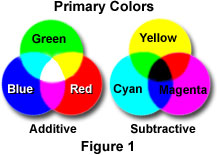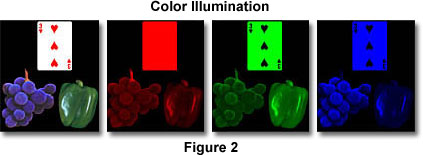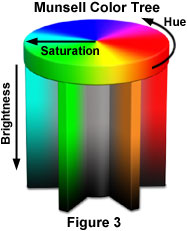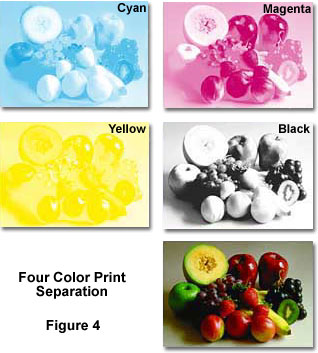Primary Colors
The human eye is sensitive to a narrow band of electromagnetic radiation that lies in the wavelength range between 400 and 700 nanometers, commonly known as the visible light spectrum. This small span of electromagnetic radiation is the sole source of color. All of the wavelengths present in visible light form colorless white light when they are combined, but can be refracted and dispersed into their individual colors by means of a prism.

The colors red, green, and blue are classically considered the primary colors because they are fundamental to human vision. All other colors of the visible light spectrum can be produced by properly adding different combinations of these three colors. Moreover, adding equal amounts of red, green, and blue light produces white light and, therefore, these colors are also often described as the primary additive colors.
| Interactive Java Tutorial | |||||||||||
|
|||||||||||
As illustrated by means of the overlapping color circles in Figure 1, if equal portions of green and blue light are added together, the resultant color is cyan. Similarly, equal portions of green and red light produce the color yellow, and equal portions of red and blue light yield the color magenta. The colors cyan, magenta, and yellow are commonly termed the complementary colors because each complements one of the primary colors, meaning that the two colors can combine to create white light. For instance, yellow (red plus green) is the complement of blue because when the two colors are added together white light is produced. In the same way cyan (green plus blue) is the complement of red, and magenta (red plus blue) is the complement of green light.
| Interactive Java Tutorial | |||||||||||
|
|||||||||||
The complementary colors (cyan, yellow, and magenta) are sometimes alternatively referred to as the subtractive primaries. This is because each one can be formed by subtracting one of the primary additives (red, green, and blue) from white light. For example, yellow light is seen when all blue light is removed from white light, magenta when green is removed, and cyan when red is removed. Consequently, when all three of the subtractive primary colors are combined, all of the additive primary colors are subtracted from white light, which results in black, the absence of all color.
Thus far this discussion has centered on the properties of visible light with respect to the addition and subtraction of transmitted visible light, which is often visualized on the screen of a computer or television. Most of what is actually seen in the real world, however, is light that is reflected from surrounding objects, such as people, buildings, automobiles, and landscapes. These objects do not produce light themselves, but emit color through a process known as color subtraction in which certain wavelengths of light are subtracted, or absorbed, and others are reflected. For instance, a cherry appears red in natural sunlight because it is reflecting red wavelengths and absorbing all other colors. The series of photographs presented below in Figure 2 helps further illustrate this concept.

In the first photograph on the left, a playing card, a green bell pepper, and a cluster of purple grapes are illuminated with white light and appear as one would expect to see them under natural lighting. In the second photograph, however, the objects are illuminated with red light. Note that the playing card reflects all of the light that strikes it, while only the grape stem and highlights on the grapes and pepper reflect the red light. The majority of the red light is being absorbed by the grapes and pepper. The third photograph shows the objects under green illumination. The different radiation wavelength causes the symbols on the playing card to appear black and the body of the card to reflect green light. The grapes reflect some green light, while the pepper appears normal, but with green highlights. The fourth photograph illustrates the objects under blue illumination. In this situation, the grape cluster appears normal with blue highlights, but the stem is invisible because it blends into the black background. The body of the playing card reflects blue light and the symbols appear black, while the pepper only reflects blue light as highlights.
| Interactive Java Tutorial | |||||||||||
|
|||||||||||
The human eye can perceive very slight differences in color and is believed to be capable of distinguishing between 8 to 12 million individual shades. Yet, most colors contain some proportion of all wavelengths in the visible spectrum. What really varies from color to color is the distribution of those wavelengths. The predominant wavelengths of a color determine its basic hue, which can be, for example, purple or orange. It is the ratio of the dominant wavelengths to other wavelengths, however, that determines the color saturation of the sample and whether it appears pale or deeply saturated. The intensity of the color and reflectivity of the object being imaged, on the other hand, determine the brightness of the color, which controls, for instance, whether something appears dark or light blue.
Over the years, various classification systems have been devised to systematically express color in terms of these concepts. One of the most widely accepted has been the Munsell Color Tree, which appears below in Figure 3. As illustrated, each color in this system is represented by a distinct position on the tree. Hue color value is represented by placement on the circumference, saturation by the horizontal distance of the color from the central axis, and brightness by the vertical position on the trunk.

When learning about color, it is also important to consider pigments and dyes, which are responsible for much of the color that appears on Earth. For instance, the natural protein pigments that are contained in eyes, skin, and hair reflect and absorb light in such a way that creates a beautiful diversity of appearances in the human race. In order to achieve a similar diversity of color in inanimate objects, such as automobiles, airplanes, and houses, they are frequently coated with pigment-containing paints and portray different shades through the process of color subtraction. Printed items, such as books, magazines, signs and billboards, create colors in the same fundamental way, but through the help of dyes or inks, rather than pigments.
All color photographs, and other images that are printed or painted, are produced using just four colored inks or dyes--magenta, cyan, yellow (the subtractive primaries) and black. Mixing inks or dyes of these colors in differing proportions can produce the colors necessary to reproduce almost any image or color. The three subtractive primaries could, in theory, be used alone. However, the limitations of most dyes and inks make it necessary to add black to achieve true color tones.

When an image is being prepared for printing in a book or magazine, it is first separated into the component subtractive primaries, either photographically or with a computer as illustrated above in Figure 4. Each separated component is then made into a film that is used to prepare a printing plate for that color. The final image is created by sequentially printing each color plate, one on top of another, using the appropriate ink to form a composite that recreates the appearance of the original.
Paint is produced in a somewhat similar manner. Again, only the subtractive primaries and black are required. Base pigments containing these colors are mixed together to form the various colors used in final paint preparations.
| Interactive Java Tutorial | |||||||||||
|
|||||||||||
A clear understanding of the color concepts previously discussed is extremely important when using a microscope to view and capture color images. Microscope light sources are usually tungsten-halogen bulbs that can emit a bright light with a color temperature around 3200 Kelvin. To the observer, this appears as white light that can be absorbed, refracted, reflected, polarized, and/or transmitted by a specimen on the microscope stage. The rules of primary colors apply to how the specimen interacts with microscope light and what colors are displayed as the sample is visualized in the eyepieces. The same rules also apply to the film used to capture photomicrographs.
Contributing Authors
Mortimer Abramowitz - Olympus America, Inc., Two Corporate Center Drive., Melville, New York, 11747.
Shannon H. Neaves and Michael W. Davidson - National High Magnetic Field Laboratory, 1800 East Paul Dirac Dr., The Florida State University, Tallahassee, Florida, 32310.
